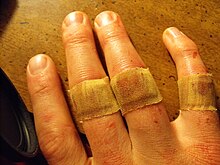First Aid Basics: Wound Care and Infections

Your skin is the largest organ of the human body and responsible for many different things relating to maintaining homeostasis.
One of the important things that skin does is protect the body from bacteria. If the skin is cut, scraped, scratched, torn, punctured, or compromised in anyway, the barricades are down and open for the enemy to get in.
This is why we’ve learned from a young age that we need to keep our wounds clean. In the last article I explained amputations and focused primarily on the hands since they are one of the more come places for appendages to go MIA.
Hands can take a beating, and paying attention to even small cuts and scrapes can help you avoid serious, and potentially life-threatening infections.
Here are somethings to help:
Wear your PPE (Personal Protective Equipment)

The old saying: “An ounce of prevention is worth a pound of cure,” is exactly what I’m talking about. If your job requires you to wear protective equipment, you should probably pay attention. At some point, someone was seriously injured and necessitated the use of PPE. There’s a reason for it. Wear your PPE.
Clean the Wound:
Irrigating the wound is important. This is especially true for wounds like punctures, since bacteria is drug down into the wound, and abrasions because dirt and other contaminants are ground into the wound.
You don’t need a special liquid for irrigation, clean tap water will do the trick nicely. Just hold it under the water for a minute or two, and flush away anything harmful. Then pat it dry with a clean paper towel and keep it protected.
If you are away from civilization, put some pressure on a camel back bladder, or punch a hole in the lid of a plastic bottle to help you achieve a forceful flushing of the wound.
If you don’t have anything else, pour water from high above the wound to help wash away any harmful substances.
Don’t Run Out of Band-Aids:
Anyone who works a trade for a living knows how often their hands are getting injured. From burns to lacerations and keeping these wounds clean is essential to prevent infection.
Months spent in hard living conditions, the most used item in my med bag was band-aids.
After the wound has been thoroughly flushed, patted dry and some antiseptic ointment has been gooped on, the next step is to ensure it remains clean and dry.
Band-Aids do a great job of this, but you need to carry a variety of different sizes and use the right size for the job. This will help to make sure the fit is good enough for the band-aid to do it right.
How Long Should I Keep the Band-Aid On?
How long you need to keep the wound covered depends on a lot of different factors. Not only does it vary between the type of wound, but also the individual.
Generally, however, a wound is considered to be healed after 10-14 days. Now, it’s important to note here that you shouldn’t keep the same band-aid in place for two weeks. Change it out anytime it falls off, gets wet or dirty, or at the end of every day.
Whenever I’m changing wound dressings, I like to let the wound sit in the open air to dry out for a bit before putting on a clean bandage. Moisture can become trapped between the bandage and the skin and cause it look white and wrinkly, like you sat in the bathtub for too long.
Keeping the wound dry is important because the damp, dark place under the bandage is a great place for bacteria to collect and multiply.
How to Spot an Infection:
You’re probably aware that wounds left uncared for run the risk of causing an infection. If the infection is left untended too, it an quickly increase in severity and become life threatening.
It’s better to avoid infections whenever possible, but sometimes we don’t get to decide.
The Sniff Test
An easy way to tell if the wound is infected, is to sniff it. Infected wounds are essentially rotting on your body, so there might be an unpleasant odor.
Temperature:
In an effort to kill the infection, your body might elevate your core temperature. If you have a suspicious looking wound, and a fever and/or body aches and chills, you should seek medical attention. It might be a sign of a serious infection requiring aggressive antibiotic therapy.
There might also be swelling and redness around the wound sight. This redness will often be very hot to the touch compared to the surrounding skin. Usually this redness will grow over time and it can be difficult to know if it’s getting worse.
You can track the redness to see if it’s getting bigger, by taking a pen and drawing around the outside edge of the redness. This way, if the redness spreads past the pen line, it will be easier to see.
Discharge:
If your wound is leaking anything that looks white, green, and/or yellow, it’s a bad sign. Often this discharge will have that unpleasant, rotting meat odor I talked about in the sniff test.
When in doubt, go to the hospital. Infections are no trivial matter, but we can do a lot by preventing them in the first place with good wound care strategies.
